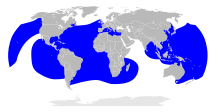Our website is made possible by displaying online advertisements to our visitors.
Please consider supporting us by disabling your ad blocker.
Leatherback sea turtle
| Leatherback sea turtle Temporal range: Holocene
| |
|---|---|

| |
| Sandy Point National Wildlife Refuge, United States Virgin Islands | |
| Scientific classification | |
| Domain: | Eukaryota |
| Kingdom: | Animalia |
| Phylum: | Chordata |
| Class: | Reptilia |
| Order: | Testudines |
| Suborder: | Cryptodira |
| Superfamily: | Chelonioidea |
| Family: | Dermochelyidae |
| Subfamily: | Dermochelyinae |
| Genus: | Dermochelys Blainville, 1816[3] |
| Species: | D. coriacea
|
| Binomial name | |
| Dermochelys coriacea | |

| |
| Synonyms[4] | |
|
List of synonyms
| |
The leatherback sea turtle (Dermochelys coriacea), sometimes called the lute turtle, leathery turtle or simply the luth, is the largest of all living turtles and the heaviest non-crocodilian reptile, reaching lengths of up to 2.7 metres (8 ft 10 in) and weights of 500 kilograms (1,100 lb).[5][6][7] It is the only living species in the genus Dermochelys and family Dermochelyidae. It can easily be differentiated from other modern sea turtles by its lack of a bony shell; instead, its carapace is covered by oily flesh and flexible, leather-like skin, for which it is named.[8] Leatherback turtles have a global range, although there are multiple distinct subpopulations. The species as a whole is considered vulnerable, and some of its subpopulations are critically endangered.
- ^ Wallace, B.P.; Tiwari, M.; Girondot, M. (2013). "Dermochelys coriacea". IUCN Red List of Threatened Species. 2013: e.T6494A43526147. doi:10.2305/IUCN.UK.2013-2.RLTS.T6494A43526147.en. Retrieved 11 October 2021.
- ^ "Appendices | CITES". Cites.org. Retrieved 14 January 2022.
- ^ a b Rhodin, A. G. J.; van Dijk, P. P.; Inverson, J. B.; Shaffer, H. B. (14 December 2010). "Turtles of the world, 2010 update: Annotated checklist of taxonomy, synonymy, distribution and conservation status" (PDF). Chelonian Research Monographs. 5: 000.xx. doi:10.3854/crm.5.000.checklist.v3.2010. ISBN 978-0965354097. Archived from the original (PDF) on 17 July 2011.
- ^ Uwe, Fritz; Havaš, Peter (2007). "Checklist of Chelonians of the World" (PDF). Vertebrate Zoology. 57 (2): 174–176. Archived from the original (PDF) on 1 May 2011. Retrieved 29 May 2012.
- ^ Chen, Irene H.; Yang, Wen; Meyers, Marc A. (2015). "Leatherback Sea Turtle Shell: a Tough and Flexible Biological Design". Acta Biomaterialia. 28: 2–12. doi:10.1016/j.actbio.2015.09.023. PMID 26391496.
- ^ "WWF - Leatherback turtle". Marine Turtles. World Wide Fund for Nature (WWF). 16 February 2007. Archived from the original on 12 October 2007. Retrieved 9 September 2007.
- ^ Cite error: The named reference
TurtlesOrgwas invoked but never defined (see the help page). - ^ Thomas, Rosamma (13 April 2021). "Indian government's development plans for the Andamans may endanger the world's largest sea turtles". Scroll.in. Retrieved 20 May 2021.
Previous Page Next Page



